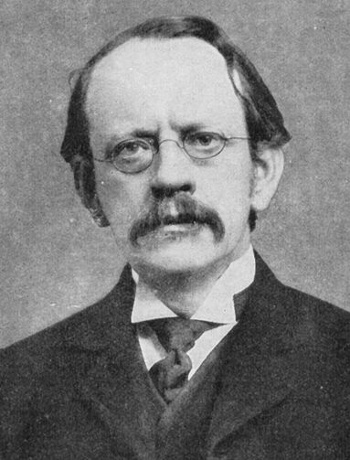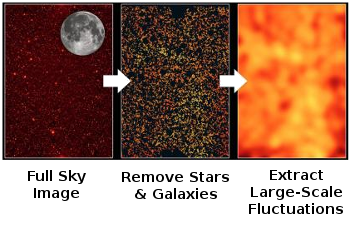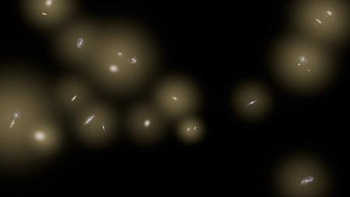Starry Galactic Halos
November 17, 2014
Analogy is one of the driving
forces in
science. If you can cast some
phenomenon in the dress of an understood phenomenon, it's possible to gain new insights. That's what happened in the early years of
atomic theory, when the
model of the
Solar System was co-opted as the model of how
electrons and
atomic nuclei are bound to each other.
At the time,
physicists needed to ignore the fact that there was a difference between having an electron
orbit a
proton and a
planet orbiting the
Sun; namely, that a
centripetally-accelerated electron would
radiate energy and spiral into the nucleus.
Isolated
atoms are one thing, but
metal atoms
coalesced into
solids show properties, such as
electrical conductivity, that indicate that not every electron remains in orbit about its nucleus. Such
delocalized electrons were actually a part of an earlier model of
matter, the
plum pudding model devised by
J. J. Thomson, who had discovered the electron in 1897.
Plum pudding, for those without knowledge of
English cuisine, does not actually contain
plums. The "plums" in this case are
raisins, and they're embedded in an
amorphous pudding base. The Thomson model consisted of electrons embedded in a sea of positive charge, so they were like
negatively-charged raisins in a
positive pudding.

Sir Joseph John Thomson (1856-1940).
Thomson, who won the 1906 Nobel Prize in Physics for the discovery of the electron, was known by his initials, "J.J."
In that sense, he was like another famous physicist, Isidor Isaac Rabi, who is always referred to as "I.I. Rabi."
(Via Wikimedia Commons.)
The structure of the
universe always seemed to mimic the simplified model of the atom, since
stars are bunched together in
galaxies with none appearing in
intergalactic space. Stars orbit around the central
black holes of their galaxies, like electrons orbit around their nucleus. However, recent observations of a diffuse
infrared glow filling the spaces between galaxies seem to indicate that some stars in the universe more closely resemble the itinerant electrons in metals than electrons bound to their nuclei.[1-7]
The observations were done as part of the
Cosmic Infrared Background Experiment (CIBER), performed by an international team from the
California Institute of Technology (Pasadena, California), the
Jet Propulsion Laboratory (Pasadena, California),
Los Alamos National Laboratory (Los Alamos, New Mexico), the
University of California (Irvine, California), the
Japan Aerospace Exploration Agency (JAXA, Kanagaw, Japan),
The University of Tokyo (Tokyo, Japan),
Seoul National University (Seoul, Korea), the
University of California (Los Angeles, California), the
Korea Astronomy and Space Science Institute (Daejeon, Korea), the
Academia Sinica (Taipei, Taiwan, Republic of China), and
Tohoku University (Sendai, Miyagi, Japan).
What was discovered was an unexpected
near-infrared halo between galaxies that's likely the signature of a huge population of
orphan stars ripped from their galaxies. It's, of course,
conjectured that these extra stars might be responsible for at least some of the universe's "
missing matter."[1-4]
Astronomers see a lot of galaxies formed from individual stars like our own
Milky Way Galaxy. Since individual stars can't be imaged for most of these, it makes you wonder what else can't be seen.[3] Studies with
NASA's Spitzer Space Telescope in 2005 had found a splotchy pattern of
far infrared light that's called the
cosmic infrared background. The splotches are much larger than individual galaxies, and some astronomers thought that this light came from the very first galaxies formed after the
Big Bang. There was the possibility, however, that the light might arise from stars ejected from their galaxies.[4,6]
CIBER was launched as four
suborbital rocket flights from the
White Sands Missile Range in
New Mexico from 2009-2013. The data for the current study is from two of these flights. The observations, at 1.1 and 1.6
micrometer wavelength, needed to be in
space, above the infrared glow of
Earth's atmosphere.[1-2] The flights of the small, ten
meter (30
foot)
sounding rockets lasted ten minutes, but they were long enough to obtain wide-angle images of the sky from two 11
cm telescopes.[4-5,7]
This extra-galactic light is suspected to arise from stars tidally stripped from their galaxies, and the number of such stars is huge.[1,6] Says JPL scientist,
James Bock,
principal investigator of the project, "the total light produced by these stray stars is about equal to the background light we get from counting up individual galaxies."[4] The light was analyzed in a two-step process in which the suborbital flights obtained wide-field images that were later stripped of galaxies using images obtained by other sources.[4-5] Techniques were used to remove the
zodiacal light caused by dust in our Solar System.[6]

CIBER data processing.
First, sky images are obtained through suborbital rocket flights. Then, known stars are galaxies are removed.
(NASA/JPL-Caltech image.)[4)]
The
research team is confident that this extra light comes from orphan stars and not from
primordial galaxies. The light is too bright to have come from that source, and it's also too blue.[4] Other astronomers are more cautious.
Steve Eales, an astronomer at
Cardiff University (Cardiff, Wales, United Kingdom), is quoted by the
BBC as saying, "When you see a result like this, you never say 'well yes that's obviously right'."[5] Research team member,
Samuel Moseley, of NASA's
Goddard Space Flight Center points out that a noticeable number of
supernovas should be sighted in intergalactic space if the conclusion is true.[7]

Artist's conception of star halos around galaxies. The stars are too small to be imaged individually.
(NASA/JPL-Caltech image.)[4)]
![]()
References:
- Michael Zemcov, Joseph Smidt, Toshiaki Arai, James Bock, Asantha Cooray, Yan Gong, Min Gyu Kim, Phillip Korngut, Anson Lam, Dae Hee Lee, Toshio Matsumoto, Shuji Matsuura, Uk Won Nam, Gael Roudier, Kohji Tsumura, and Takehiko Wada, "On the origin of near-infrared extragalactic background light anisotropy," Science, vol. 346 no. 6210 (November 7, 2014), pp. 732-735, DOI: 10.1126/science.1258168.
- Michael Zemcov, Joseph Smidt, Toshiaki Arai, James Bock, Asantha Cooray, Yan Gong, Min Gyu Kim, Phillip Korngut, Anson Lam, Dae Hee Lee, Toshio Matsumoto, Shuji Matsuura, Uk Won Nam, Gael Roudier, Kohji Tsumura, and Takehiko Wada, "On the origin of near-infrared extragalactic background light anisotropy," arXiv, November 5, 2014.
- S. H. Moseley, "Perspective, Astronomy - The other half of the universe?" Science, vol. 346 no. 6210 (November 7, 2014), pp. 696-697, DOI: 10.1126/science.aaa1077.
- Kathy Svitil, "Caltech Rocket Experiment Finds Surprising Cosmic Light," California Institute of Technology Press Release, November 6, 2014.
- Jonathan Webb, "Background light suggests many stars 'outside galaxies'," BBC News, November 6, 2014.
- Pete Spotts, "Orphan stars could be window into visible universe's 'hidden half'," Christian Science Monitor, November 6, 2014.
- Daniel Clery, "Rogue stars outside galaxies may be everywhere," Science, November 6, 2014.
- CIBER Web Site, California Institute of Technology.
Permanent Link to this article
Linked Keywords: Analogy; force; science; phenomenon; atomic theory; conceptual model; Solar System; electron; atomic nucleus; atomic nuclei; physicist; orbit; proton; planet; Sun; centripetal acceleration; centripetally-accelerated; electromagnetic radiation; radiate; energy; atom; metal; freezing; coalesce; solid; electrical conductivity; delocalized electron; matter; plum pudding model; J. J. Thomson; plum pudding; England; English; cuisine; plum; raisin; amorphous; pudding; electric charge; negatively-charged; positive; Sir Joseph John Thomson (1856-1940); Nobel Prize in Physics; Isidor Isaac Rabi; Wikimedia Commons; universe; star; galaxy; galaxies; intergalactic space; black hole; infrared; Cosmic Infrared Background Experiment (CIBER); California Institute of Technology (Pasadena, California); Jet Propulsion Laboratory (Pasadena, California); Los Alamos National Laboratory (Los Alamos, New Mexico); University of California (Irvine, California); Japan Aerospace Exploration Agency (JAXA, Kanagaw, Japan); The University of Tokyo (Tokyo, Japan); Seoul National University (Seoul, Korea); University of California (Los Angeles, California); Korea Astronomy and Space Science Institute (Daejeon, Korea); Academia Sinica (Taipei, Taiwan, Republic of China); Tohoku University (Sendai, Miyagi, Japan); near-infrared; orphan; conjecture; dark matter; missing matter; astronomer; Milky Way Galaxy; NASA; Spitzer Space Telescope; far infrared light; cosmic infrared background; Big Bang; suborbital; rocket; White Sands Missile Range; New Mexico; micrometer; wavelength; outer space; Earth's atmosphere; meter; foot; sounding rocket; centimeter; cm; telescope; James Bock; principal investigator; zodiacal light; data processing; research; primordial; Steve Eales; Cardiff University (Cardiff, Wales, United Kingdom); BBC; Samuel Moseley; Goddard Space Flight Center; supernova.